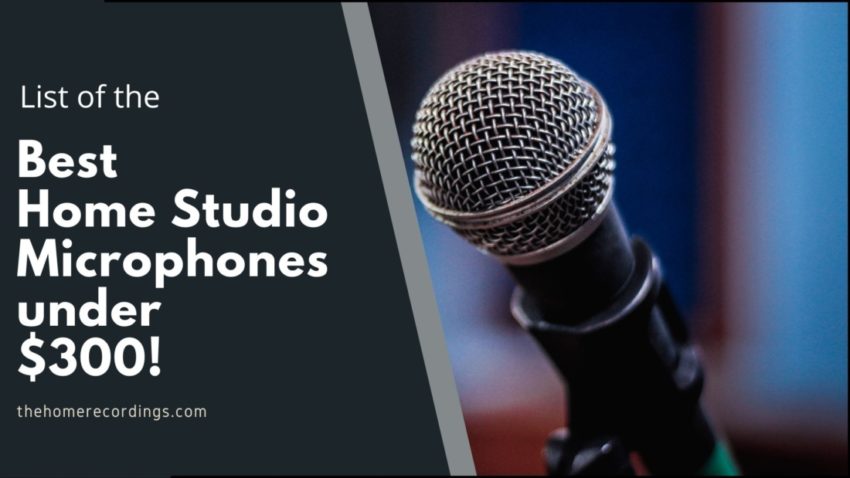Last updated on December 29th, 2023 at 09:50 pm
One of the essential components of every Home Studio is the microphones, but which ones should you get, since there are way too many to choose from?
First of all, let me say that there are extremely good microphones out there for a surprisingly low price which will definitely allow you to create professional-sounding songs without the need of spending a fortune on high-end microphones.
Should you just get one microphone? Not really. Not every microphone sounds the same, one might sound absolutely fantastic when recording an acoustic guitar but terrible when recording a different one.
So, having at least two, especially different kinds of microphones such as a condenser and a dynamic one, is essential.
I’d recommend one large Diaphragm Condenser microphone and also a Dynamic one for starters, and if the budget allows for it, a pair of Small Diaphragm Condenser mics, or matched pairs as they are usually referred to.
In this post, I will list my favorite Microphones that cost no more than $300!
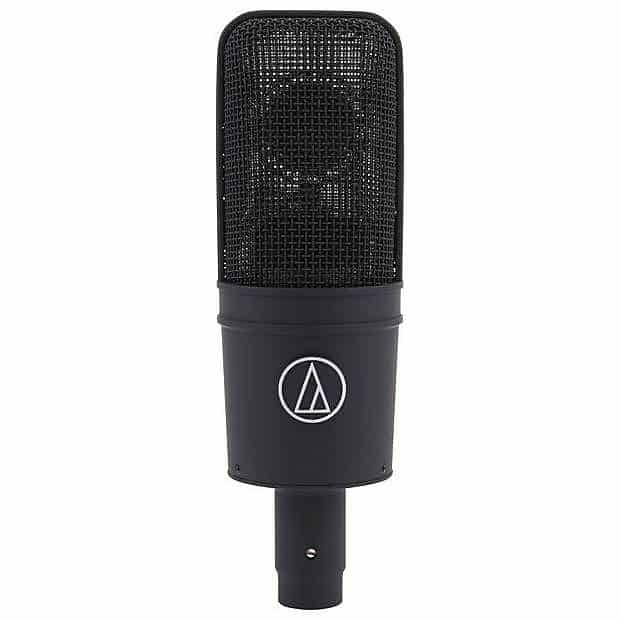
AT4040
Best Large Diaphragm Microphone you can get in the $300 price range.

Rode M5
Excellent set of Matched-Pair small diaphragm condenser microphones!
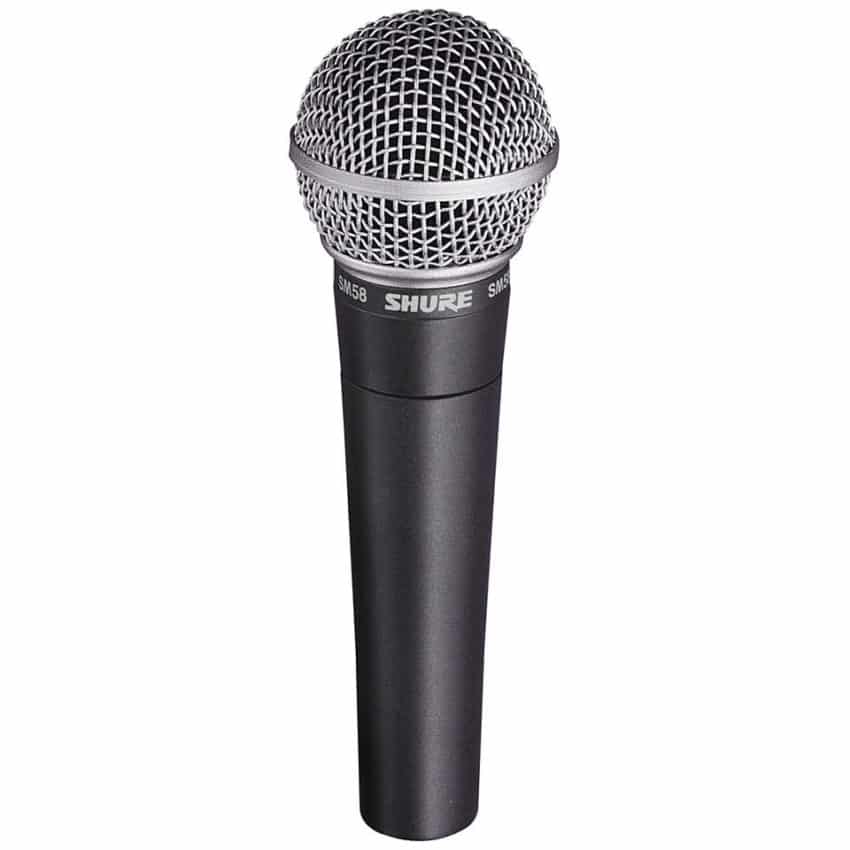
Shure SM58
It’s the industry standard dynamic microphone for recording vocals.
You might also be interested in reading about the Best USB Microphones available. Here’s the post I wrote on that topic.
Small Diaphragm vs Large Diaphragm, what’s the difference?
Small diaphragm condenser mics tend to be more accurate in reproducing the acoustic signal and they are mostly used as instrument mics and recording mics for ensembles.
Large-diaphragm condenser mics tend to be less accurate but produce a warm and unique signal that enhances vocals really well.
Having said that, there are no strict rules, every microphone can be used to record whatever you want, it all depends on how YOU feel the sound is being recorded.
What is Self Noise
It’s the signal a microphone produces of itself with no sound source present.
This is one of the most important specifications since we don’t want noisy recordings, for instance, the Aston Origin has a Self Noise of 18dB while most other mics have a quite lower one.
I will detail this on every microphone on this list.
What is SPL?
Max SPL stands for Maximum Sound pressure level and it’s the amount of sound pressure a microphone withstands before distorting the sound.
Many people think that it’s the maximum amount of sound pressure a microphone can take before breaking, but this is false.
Best Large Diaphragm Condenser Microphones
Large Diaphragm Microphones have a large membrane that captures more acoustic energy, generating a higher signal voltage, which gives them better noise performance than small diaphragm ones.
They are mostly used for recording Vocals and spoken word. This is because they shape the sound in a pleasing way.
Although they are mostly used for vocals, they also work extremely well for recording instruments such as an Acoustic Guitar: Placing the mic about a foot to two feet away from the soundhole will get you a great sounding recording.
A large Diaphragm Condenser Mic can also be used as an overhead for your drum kit, as long as it’s not too close so you don’t overload it.
Overloading can be a bit of an issue when recording really loud sources such as a Guitar Amp, Snare Drums, etc. In that case, if the microphone has a PAD switch you should use it, otherwise, I’d recommend trying a Dynamic Microphone.
Remember that condenser microphones need 48v Phantom Power to be driven, make sure that your Audio Interface can provide this (most ones can nowadays, even the cheaper ones).
My Top choices for Large Diaphragm Condenser Microphones are;
Audio-Technica At4040
The absolute best Condenser Microphone under $300!

The build quality of the Audio-Technica AT4040 is as you would expect for any microphone at this price point, if treated properly it should last you a lifetime.
It’s got an all-metal body and a metal grille (which doesn’t come with anything to protect against plosives so buying a windscreen would be a wise choice).
It has two switches on the back which are: A High-pass Filter, which rolls lower frequencies off at about 80Hz at 12dB/octave, and a -10dB PAD in case you are recording really loud sound sources.
It’s the best-sounding mic on this list, in my opinion, which is why I’m giving it the first spot on this list since I don’t think that you will ever need to upgrade from it since there’s just no need, plus having the added HPF and PAD switches is a really nice bonus and I would definitely recommend it as an upgrade on any of the budget condenser microphones.
Pros
- It has a very smooth-sounding frequency response, especially in the lower frequencies.
- It has a boost to the presence and air frequencies, which makes it sound really open.
- PAD Switch.
- High-Pass Filter.
- Great build quality.
Cons
- The proximity effect can be a bit too much, it can sound a bit too boomy (good thing it has the High-pass filter to deal with this issue).
- A bit sibilant at times.
What comes in the Box?
- Microphone
- Shock mount with 5/8 to 3/8-inch microphone-stand adaptor
- It comes with a pouch that isn’t that great but that will help with avoiding dust buildup.
Specifications
- Polar Pattern: Cardioid
- Frequency Response: 20Hz – 20Khz
- SPL: 145dB or 155dB (with PAD engaged)
- Impedance: 100 ohms
- Sensitivity: -32dB (25.1mV)
- Self Noise: 12dB
Find out more about the Audio-Technica AT4040 here:
- Audio-Technica AT4040: Amazon, Sweetwater.
The Audio-Technica AT4040 is a microphone to consider when building your first home studio.
Aston Origin
Built-in Metal Wool Mesh Pop Filter!
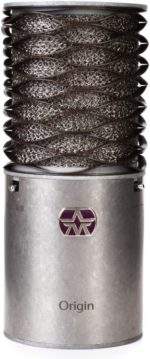
The Aston Origin was designed and built in the UK by Aston, which is quite new to the whole microphone scene and this model, the Origin, is the first of their line.
I had never seen a microphone like this before, it looks completely different from what I’m used to and I quite like it to be honest.
Its build quality feels extremely good since it has a very sturdy and durable design.
One really cool thing about this microphone is that it doesn’t really need a pop-filter since it’s got a sort of metal wool mesh that really does a great job at not letting the plosives get through.
This microphone also comes equipped with a -10dB Pad Switch and an 80Hz High pass filter.
The Aston Origin can be mounted directly to the stand, this is if you don’t need a shock mount, which in most cases you probably won’t need since the internal shock mount actually does a very decent job at separating the capsule from the stand.
If you need to angle the mic, then you could consider getting one.
This microphone has a waveform head which is sprung steel that acts as a shock absorber for the mic. They assure you that if you drop it, thanks to this absorber you won’t damage the mic… I personally haven’t tried this and I hope I never drop it, still a great feature to have.
This is a great-sounding mic and it’s incredibly competitive for its price. It has a very well-balanced frequency response of 20Hz – 20kHz with a gradual low roll-off starting at 120Hz, and it has a slight boost in the higher mids peaking at 12kHz before going back down to 0dB at 20kHz.
The lower mids however feel a bit too cut out.
Pros
- Built-in shock absorber.
- Built-in pop filter.
- It doesn’t have a paint finish but rather a 2mm solid stainless-steel finish that won’t scratch and will look just as good today as it will in ten years.
- Can be mounted directly to the mount.
- 3-year warranty.
- Great mid-range response.
Cons
- Doesn’t include a shock mount in the box.
- Doesn’t come with a case.
- Slightly noisy.
What comes in the Box?
- Only the microphone
Specifications
- Polar Pattern: Cardioid
- Frequency Response: 20Hz – 20kHz
- SPL: 127dB or 137dB (with PAD engaged)
- Sensitivity: 23.7mV
- Self Noise: 18dB
If it wasn’t for the high self-noise I would have probably put this one first on the list, if this isn’t really an issue for you then you should absolutely give the Aston Origin a try.
Find out more about the Aston Origin here:
- Aston Origin: Amazon, Sweetwater.
SE Electronics sE2200a II C
Excellent Condenser microphone with a PAD and HPF!
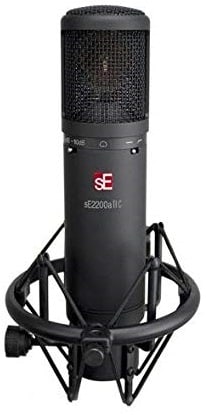
Just like with the first microphone on this list, the sE Electronics sE2200a II C is extremely well built. It’s got quite a bit of weight to it which I really like, the body and the grille are all metal and it just feels very durable.
According to their website, this microphone is hand-built, cool Huh?
This one also comes with two switches, which are on the front of the microphone that provides a -10dB PAD and a High Pass filter that rolls off at around 60Hz.
The frequency response is pretty much flat and almost anything you record will sound absolutely great, be it vocals, acoustic or electric guitars, etc. but compared to other condenser microphones, it doesn’t have that same “air” and space feel to it.
The only complaint I have is that the shock-mount that comes with the microphone isn’t the best one out there, it feels a bit cheap.
Pros
- Great flat Frequency response.
- PAD Switch.
- High-Pass Filter.
- Great build quality.
- Great for spoken word, singing, acoustic instruments, and electric guitar.
Cons
- Fairly large polar pattern (Unless you have a treated room you will get some noise bleeds). This is especially true for podcasting and gaming.
- The shock-mount feels cheap.
- The pop filter has fairly pointy edges.
What comes in the Box?
- Microphone
- Shock mount
- 5/8 to 3/8-inch microphone-stand adaptor
- Pop-Filter that mounts on the shock-mount
Specifications
- Polar Pattern: Cardioid
- Frequency Response: 20Hz – 20kHz
- SPL: 135dB or 145dB (with the PAD switch engaged)
- Impedance: 200 Ohms
- Sensitivity: -32dB (25.12mV)
- Self Noise: 14dB
Find out more about the SE Electronics sE2200a II C here:
- SE Electronics sE2200a II C: Amazon, Sweetwater.
Rode NT1
Comes with a high-quality pop filter and a shock mount!

The Rode NT1, as well as the two microphones I described earlier, also has a great build quality. Both the body and the grille are metal and it feels pretty heavy, which is great.
The Rode NT1 comes with a shock mount and the best pop filter I’ve ever seen since it has a dual layer that is much better at dispersing the plosives than conventional pop filters.
The only issue with this filter is that it has to be placed directly into the shock mount, which means that it can only be used with the Rode NT1.
It has a fairly flat frequency response, only rounded cuts at 20-30Hz and 16k-20kHz.
Overall it has a full tone without having a boomy low end, plus the high-end sounds really bright without being “shrill” or anything. One thing though, according to many reviews I read online, is that it tends to be a bit sibilant.
Still, an incredible piece of technology.
The Rode NT1 can run on both 24v and 48v Phantom Power.
Pros
- Best Pop filter ever included.
- The shock mount is of great quality.
- Great Build Quality.
Cons
- Might be a bit too bright sounding for some ears.
- Sometimes more sibilant than other microphones.
- No PAD or Low-Cut Switches.
What comes in the Box?
- The Microphone.
- A Microphone Pouch.
- The shock-mount.
- And the Pop Filter.
Specifications
- Polar Pattern: Cardioid
- Frequency Response: 20Hz – 20kHz
- SPL: 132dB
- Sensitivity: -29.0dB
- Self Noise: 4.5dB
Find out more about the Rode NT1 here:
- Rode NT1: Amazon, Sweetwater.
Blue Bluebird SL
Warm and crispy sound!

From an appearance standpoint, I think that this is by far the best-looking microphone out there, I absolutely love the way it looks!
But this isn’t really relevant to the topic of this article, the important thing is that it can deliver great recordings.
It has a Low-Cut or High-Pass filter which rolls of frequencies starting at around 100Hz at 12dB/octave and a -20dB PAD.
This mic has a sort of crunchy tone which I personally don’t like that much, it sounds a bit “distorted” in the higher frequencies.
The two instances that I would really use this one are if I’m recording an acoustic guitar and I feel like it needs a bit of extra punch, or if I also wanted to add a bit more of a crunchy feeling to my vocals.
But when mic-ing a cabinet and playing some crunchy tunes I didn’t quite like it, I felt it was a bit harsh.
This microphone is great for specific applications and you are the one who needs to decide whether or not it can benefit you. I wouldn’t recommend it for voiceover work though.
Pros
- PAD and High-Pass Filter.
- Great Build Quality.
Cons
- Susceptible to sibilance.
- Crunchy higher frequencies.
What comes in the Box?
- Everything comes in a really beautiful wooden storage box.
- You get the Microphone and a shock mount which comes with a 5/8 to 3/8 inch microphone stand adapter.
Specifications
- Polar Pattern: Cardioid
- Frequency Response: 20Hz – 20kHz
- SPL: max 138dB
- Impedance: 50 Ohms
- Sensitivity: -31dB
- Self Noise: 11.7dB
Find out more about the Blue Bluebird SL here:
- Blue Bluebird SL: Amazon, Sweetwater.
Rode NT1a
Fairly bright-sounding microphone that comes with some extras!
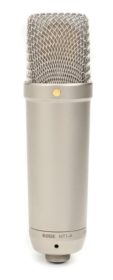
The Rode NT1a is the Rode NT1’s older brother and it does what you want it to do since it will give you a very accurate representation of what is being played in the room and it will translate properly into the mix.
It has a very natural sound, even though after reading some reviews online I found that people complained about it having a bit of a harshness or high frequency/presence boost which is actually quite common on microphones at this price range, but I use this microphone on a daily basis and actually really like the way it sounds.
The Rode NT1-A doesn’t come with a PAD or High-Pass filter, it’s just the bare microphone but it is a great performer, doing what it’s supposed to do.
It has a slight boost at around 150Hz and the 6k to 12kHz range, with a deep cut at the high-end, this means that it will be actually somewhat bright-sounding.
In comparison, the NT1 has a much flatter frequency response, which is ideal if you’re familiar with how to EQ properly.
This means that the NT1a will probably sound better straight out of the box, but the NT1 will let you customize the sound to your liking a bit better.
I found it great for recording vocals, acoustic guitar, and electric guitar, but to be honest, once you get to this level of microphones it gets hard to really find one that doesn’t do what it’s supposed to. It all comes down to your own preferences, what kind of tone you’re going for, etc.
Pros
- Build quality is fantastic.
- The shock mount is metal, compared to most of the ones on this list which are plastic.
- It’s insanely quiet.
Cons
- The presence boost could make your recordings too bright potentially. It can also make your vocals a bit more sibilant.
What comes in the Box?
- You get the Microphone.
- A Storage Pouch.
- You also get the shock mount which comes with a pop filter already attached.
- XLR cable.
Specifications
- Polar Pattern: Cardioid
- Frequency Response: 20Hz – 20kHz
- SPL: max 137dB
- Impedance: 100 Ohms
- Sensitivity: -32dB
- Self Noise: 5dB
Find out more about the Rode NT1a here:
- Rode NT1a: Amazon, Sweetwater.
Sennheiser MK4
Excellent background noise rejection!

Just like all the microphones on this list, the build quality of the Sennheiser MTK4 is just fantastic, it has an all-metal body and grille and it’s also quite heavy, but as I mentioned, this is to be expected at this price range.
When it comes to the frequency response, this microphone has a slight roll-off in the low end, a slight boost in the 2kHz – 10kHZ, and then another roll-off from 10kHz – 20kHz, meaning that it has a very nice and subtle coloration.
This one does a surprisingly good job (better than most other microphones on this list, at least to me) at background noise rejection.
I would use this one primarily to record vocals plus acoustic guitars since I didn’t really like the way it recorded electric- slightly overdriven- guitar.
It’s still great for electric, don’t get me wrong, but if that’s your primary focus, I would go with the Audio-Technica AT4040.
Pros
- Great build quality.
- Very natural sounding.
Cons
- No shock mount included.
- No PAD or High-Pass filter switches.
- This isn’t a real important con, but it’s not really good looking like the Blue Bluebird SL.
What comes in the Box?
- First of all, you get the microphone.
- You also get a carrying bag, which seems to be quite good. It will at least help avoid the dust buildup.
- It also comes with the 5/8 to 3/8-inch microphone stand adapter.
Specifications
- Polar Pattern: Cardioid
- Frequency Response: 20Hz – 20kHz
- SPL: max 137dB
- Impedance: 50 Ohms
- Sensitivity: -32dB
- Self Noise: 10dB
Find out more about the Sennheiser MK4 here:
- Sennheiser MK4: Amazon, Sweetwater.
Audio-Technica At2050
Cardioid, Omni, and Bidirectional polar patterns!
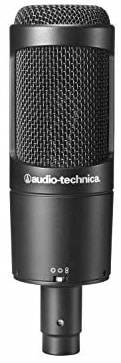
The Audio-Technica AT2050 is a Multi-Pattern microphone, in comparison to all the ones I described earlier which are Cardioid.
The build quality is great, it has an all-metal body and all-metal grille.
Now, this is where this one is different from the rest of the microphones on this list; When you look at the front you can see a switch that will allow you to choose between three different recording patterns: Cardioid, Omni-Directional, and Bi-Directional.
On the back, you will find a -10dB PAD and a High-Pass Filter that will roll off lower frequencies from 80Hz downwards.
This one is a lot more versatile than the other ones on this list. The thing is that you will probably only ever use it in cardioid, especially if you are recording at home by yourself.
But since you are also able to engage a High-Pass filter and switch the polar patterns, you really get a lot of choices!
Using Omni or Bi-Directional might be good if you want to record a conversation with a group of people or if your intentions are to record a big ensemble, but otherwise, you will always be using it in Cardioid mode.
If you also have another microphone you could use them both to record using the MID-Side technique which involves using a Bi-Directional microphone to pick up the stereo image and a cardioid microphone that is facing directly towards the source.
Read more about how to record using MID-Side Here.
I really like this one for recording acoustic guitar, not so much for electric though, and also not for vocals, at least mine. I found it to be a bit too bright and not so clear on the lower frequencies.
This might be because on all the patterns there is a slight cut in the low end starting at about 100Hz -300Hz depending on the pattern and it also has a boost in the High Mids, which could explain the brightness.
Pros
- Good build quality.
- Really Versatile, good for recording ambient sounds or meetings, etc.
- Can be used for Mid-Side recording.
Cons
- Can sound a bit too bright and crunchy.
- Lows aren’t the best.
What comes in the Box?
- Obviously, you get the Microphone.
- It also comes with the shock mount that comes with the 5/8 to 3/8-inch microphone stand adapter.
- It also comes with a very nice padded leather pouch. Of all the microphones on this list, it’s the best pouch/bag you get.
Specifications
- Polar Pattern: Cardioid, Omni-Directional and Bi-Directional.
- Frequency Response: 20Hz – 20kHz
- SPL: max 149dB – 159dB (with PAD engaged)
- Impedance: 120 Ohms
- Sensitivity: -42dB
- Self Noise: 17dB
I would suggest you buy this one as a second option after getting one of the others on this list like the Audio-Technica AT4040 or the Aston Origin, this way you will have two completely different microphones that do different things. Using the Mid-Side recording technique is really cool, you should try it!
Find out more about the Audio-Technica At2050 here:
- Audio-Technica At2050: Amazon, Sweetwater.
If I had to recommend you one of these… just one, I’d say go with the Audio-Technica AT4040, I think it’s the absolute best on this list, but they are all extremely good.
Important Note: All these microphones require Phantom Power, make sure your Audio interface can provide it. If you don’t have an Audio interface then you could read this post about the best audio interfaces under $300.
Small Diaphragm Condenser Microphones
Small Diaphragm Condenser Microphones are the go-to choice when recording instruments, ensembles, or choirs since they can capture their natural sound, without added flavors, plus these applications work best with stereo pairs.
No other microphone can do this as well, but remember that it all comes down to what you actually prefer!
When recording acoustic guitar, more often than not you will use these microphones, but sometimes you might like the sound a Large Diaphragm Condenser gives.
Rode M5 (Matched Pair)
Best Matched-Pair in terms of Cost-efficiency!

The Rode M5 only sell as a matched pair.
It has a black-matte ceramic coating, which is both durable and really good-looking. The microphone comes with a WS5 pop filter and an RM5 stand mount.
It has a slight presence boost at the 7kHz mark and a bit of a roll-off at the really low and high end.
I think this microphone is the best in terms of what you get for the money. They sound great and don’t color the sound at all.
The Rode M5 doesn’t come with a PAD or a High-Pass filter, which shouldn’t really be an issue though.
Pros
- The build quality is better than the one of other budget microphones.
- Great sound quality.
Cons
- Doesn’t come with a storage pouch.
- Fixed, non-removable capsules.
- Doesn’t have a PAD or High-Pass filter.
- Self-noise might be a bit too high for some people (19dB).
What comes in the Box?
- You get the two Rode M5s, the Windscreens, and the mic stand mounts.
Specifications
- Polar Pattern: Cardioid
- Frequency Response: 20Hz – 20kHz
- SPL: max 140dB
- Impedance: 200 Ohms
- Sensitivity: -34dB
- Self Noise: 19dB
This is my favorite pencil microphone because I don’t really think that you can get any other pair that is better for the price. The next one on the list, the Rode NT5 is definitely better, but costs almost twice as much.
Find out more about the Rode M5 here:
- Rode M5: Amazon, Sweetwater.
Rode NT5 (Matched Pair)
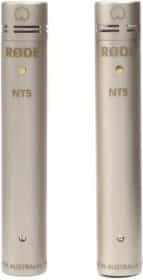
The Rode NT5 is a definite step up from the Rode M5, but it’s also worth almost twice as much.
What makes the NT5 stand out over the M5 is that its capsules can be interchanged. This is also really good if you actually need to replace one that’s broken.
The Capsules you can buy are the NT45-C (Cardioid) and the NT45-o (Omnidirectional).
If you have a bit of extra cash, these are definitely the ones you should get. I got them thinking that I would only use them until I had the money to buy some of the more expensive ones, but I was honestly amazed at how well they sounded. I use them all the time.
Pros
- Fantastic sound quality for the price.
- Don’t really need to use corrective EQ at all.
Cons
- Doesn’t have a PAD or High-Pass filter.
What comes in the Box?
- You get the two Rode NT5, the Windscreens, and the mic stand mounts.
- The Box itself is really good quality and comes with extra room, should you decide to buy the extra capsules.
Specifications
- Polar Pattern: Cardioid
- Frequency Response: 20Hz – 20kHz
- SPL: max 143dB
- Impedance: 100 Ohms
- Sensitivity: -38dB
- Self Noise: 16dB
Find out more about the Rode NT5 here:
- Rode NT5: Amazon, Sweetwater.
If you’re looking for the best budget stereo pair microphones, I wrote an entire post on which I think are the best ones that won’t really cost you an arm and a leg but still get you sounding amazing.
MXL V67N

Not to be confused with the MXL V67g which is a Large Diaphragm Condenser Microphone, the MXL V67N has a really good-looking green finish with its brand and model number written in gold on the front. This microphone isn’t as well known as the others on this list, but it’s definitely a good choice to take into consideration.
Just like the NT5, this microphone has interchangeable capsules which are Cardioid and Omnidirectional but you don’t need to buy them extra, since they come with the microphone.
This microphone is a bit more pricey if you consider that you would probably be purchasing two to have stereo pairs.
If I had to choose, I’d go with the NT5 over this one unless you can’t afford to spend the couple extra bucks that the NT5 costs.
Pros
- Interchangeable Capsules.
- Has a very balanced sound.
Cons
- One issue I found when reading across forums is that according to a lot of people this microphone tends to stop working. It doesn’t look to be as reliable as the others on this list! I’ve never had that issue though.
- Doesn’t have a PAD or High-Pass filter.
What comes in the Box?
- The microphone, a cleaning cloth, the Omnidirectional Capsule, and the Mic stand mount.
Specifications
- Polar Pattern: Cardioid and Omnidirectional
- Frequency Response: 20Hz – 20kHz
- SPL: max 148dB
- Impedance: 150 Ohms
- Sensitivity: -49dB
- Self Noise: 16dB
MXL V67N is a great option if you want something in between the M5 and the NT5.
Find out more about the MXL V67N here:
- MXL V67N: Amazon.
Last but not least on the Small Diaphragm Condenser Microphone list we have…
Samson C02 (matched pair)

The difference between this mic and the rest is its pattern, since the Samson C02 offers a super-cardioid pattern which means that it’s even more directional than a cardioid. The issue is that it also picks up some sound from the back, which can make positioning somewhat tricky. But it will reject a lot more from everywhere else.
Now, this is what they state on their official website, but from testing it I find that it works as a regular cardioid.
This is the cheapest one on the list, you can get the two microphones plus a two cables bundle for next to nothing.
The capsules are interchangeable but you can’t really get ones with a different polar pattern, but if the module needs to be replaced it’s really simple.
Pros
- Great starter option.
Cons
- It’s not the quietest microphone out there.
What comes in the Box?
- The two microphones, the mic stand mounts, and two windscreens.
Specifications
- Polar Pattern: Super-Cardioid
- Frequency Response: 50Hz – 20kHz
- SPL: max 134dB
- Impedance: 200 Ohms
- Sensitivity: -40dB
- Self Noise: 22dB
This is a great option if you don’t want to spend too much or if you don’t have any experience with pencil microphones and you want to try them out.
Find out more about the Samson C02 here:
- Samson C02: Amazon, Sweetwater.
Important Note: All these microphones also require Phantom Power, just like the Large Diaphragm Condensers, make sure your Audio interface can provide it.
If you don’t have an Audio interface then you would need to get one, if you are just starting out or you could read this post I wrote about two really affordable yet great Audio Interfaces.
Dynamic Microphones
The biggest advantage of using Dynamic Microphones is that they are extremely good for live performances since it’s a lot harder for them to create feedback.
Still, many pro producers use them in their recording studios depending on what kind of sound they are looking for, so in a sense, these would be the most versatile of the whole list.
Sennheiser e945

This is a super-cardioid microphone, which as stated earlier, is a bit more directional than a normal cardioid.
It has a super low handling noise and it’s built like a tank… Almost all dynamic microphones are though, you could run them over with your car, pick them up and use them, no problem.
It has a very clear and professional sound and it rarely creates feedback.
Honestly, I think this is a great microphone overall and for the price, you can’t really go wrong.
Pros
- Incredible build.
- Clear sounding.
- 10-Year Warranty.
- Great at rejecting noise.
Cons
- It works best with higher-pitched voices e.g. females. Great for male vocals too but if you have a really deep voice you might not like it as much.
What comes in the Box?
- The microphone, a protective pouch, and the microphone clip.
Specifications
- Polar Pattern: Super-Cardioid
- Frequency Response: 40Hz – 18000kHz
- SPL: No real issues with Dynamic microphones
- Impedance: 350 Ohms
- Sensitivity: -54dB
Find out more about the Sennheiser e945 Here:
- Sennheiser e945: Amazon, Sweetwater.
This is an excellent microphone, but if you ask me… the next one on the list is the best one.
Heil PR 35

The Heil Sound PR 35 is an incredibly versatile vocal mic. It has an amazing amount of rear rejection but exhibits no off-axis coloration, so it is like having a super-cardioid and Omni mic in one.
It comes with a low-cut roll-off switch.
The ports which are used to give the mic its directional properties are much further back than on a traditional mic, which means that it’s going to be much harder to cover them.
Some people tend to cover up those ports on most microphones when they hold them too close to the capsule, this tends to cause feedback and also flatten out your sound.
Heil has found a pretty cool way around this it seems.
I would absolutely recommend you get this one over any other dynamic mic on this list if you’re planning on using it for live shows, I think it’s the clear winner when it comes to live gigs.
Pros
- Low-cut roll-off switch.
- Great at avoiding feedback.
- Harder to thin out the tone since covering the ports is harder.
Cons
- Price, it’s definitely a lot more expensive than a Shure SM58 which has always been the go-to in live performances.
What comes in the Box?
- It comes in a very nice padded carrying case. You also get the Microphone, a pop filter, mic stand mount, and different color rings that can be attached to the mics if you are using several ones, for easy identification.
Specifications
- Polar Pattern: Cardioid
- Frequency Response: 40Hz – 18000kHz
- SPL: No real issues with Dynamic microphones
- Impedance: 600 Ohms
- Sensitivity: -52.9dB
Find out more about the Heil PR 35 here:
- Heil PR 35: Amazon.
Shure SM57 and SM58
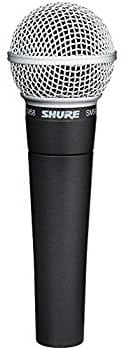
These two microphones are completely identical, the only difference is the grille.
The SM58 is designed for vocal applications, and therefore uses a ball grille with a built-in pop filter.
The SM57 is designed as an instrument microphone. That’s why the grille is smaller since it doesn’t have to account for plosives. It could be used for vocals, but you would need an external pop filter.
Both of these microphones are extremely sturdy, and really well built and you probably noticed this but everyone uses them, in studios, live performances… they are everywhere.
There’s a great reason for this, they both perform great and last forever while being very affordable.
If you don’t want to spend a lot on the Heil PR35, then I honestly think you should go with one of these.
They don’t sound as bright as other microphones, like the Sennheiser e945, which depending on the situation can be good or bad.
Pros
- Incredibly durable.
- Great sound.
Cons
- More prone to feedback than the Heil PR35.
What comes in the Box?
- You get the Shure SM58 or SM57 with a mic stand mount.
Specifications
- Polar Pattern: Cardioid
- Frequency Response: 50Hz – 15000kHz
- SPL: No real issues with Dynamic microphones
- Impedance: 300 Ohms
- Sensitivity: -56dB
Find out more about the Shure SM58 and SM57 here:
- Shure SM58: Amazon, Sweetwater.
- Shure SM57: Amazon, Sweetwater.
Conclusion
Choosing a microphone isn’t easy, there are way too many choices out there… but you need to start somewhere.
For Home recording, I’d recommend the Audio-Technica AT4040. Then you could pick up something like the Rode M5 or the Rode NT5 which will allow you to get great stereo recordings.
If you are looking for a fantastic microphone for live performances, then I’d recommend the Heil PR35. If the price is too high for you, simply go with a Shure SM58 for now. You can still use any of these two for Home Recording.
This would be just the basics, once you have one or two microphones you can start to think about adding some to your collection.
I hope this information was useful! See you on the next one.
